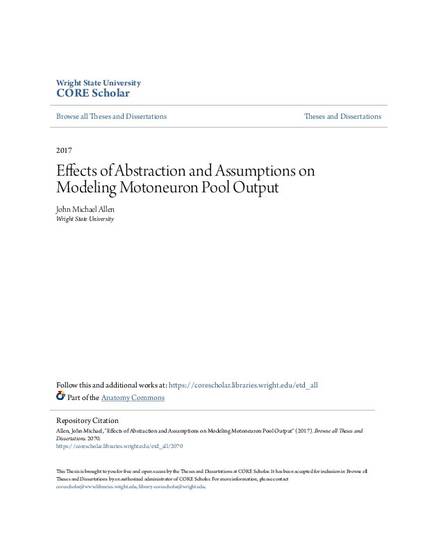
Thesis
Effects of Abstraction and Assumptions on Modeling Motoneuron Pool Output
(2017)
Abstract
Computational modeling has long been used in neuroscience as a supplement to more traditional experimental techniques, as it provides some advantages in terms of the level and detail of control available over the system being studied. At the same time, modeling has significant disadvantages by virtue of adding additional uncertainty to results and forcing the definition of potentially unclear physiological mechanisms. Nevertheless, modeling can provide useful insights when carefully defined and constrained. In this thesis, a model of the a-MN pool innervating the cat medial gastrocnemius was constructed. This model was then used to address two major questions, one regarding modeling technique and the other physiological methods of motor control. Regarding modeling technique, the original pool model was developed with distinct properties representing the different physiological types of a-MNs. Properties of these types were spread such that significant overlap was present between them, as shown in experimental results. However, similar models are often developed without inclusion of this feature. By removing the overlap from this model, it was shown that inclusion, or lack thereof, of electrophysiological property overlap has significant impact on model results. Additionally, experimental evidence has shown that a-MNs of lower input resistance innervating muscles of the cat hind limb receive greater synaptic current from volitional input than do those of higher input resistance. To test the significance of this finding, a control scheme was adopted in which input to cells varied as IN, S < IN, FR < IN, FF. The results of this test seem to support assertions made by others, that the size principle, which is often considered in an AHP depth and duration dependent manner, is most applicable when comparing to in vitro electrical stimulation, and that an “onion-skin” pattern of recruitment, in which the fastest-firing units are recruited first, is more applicable when considering volitional input.
Keywords
- Computational modeling,
- Motoneuron
Disciplines
Publication Date
Spring April 12, 2017
Degree
Master of Science (MS)
Department
Neuroscience, Cell Biology and Physiology
Citation Information
John Michael Allen. "Effects of Abstraction and Assumptions on Modeling Motoneuron Pool Output" (2017) Available at: http://works.bepress.com/nasser_kashou/45/
